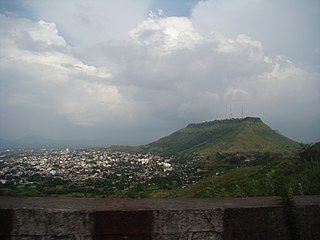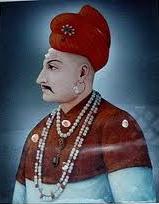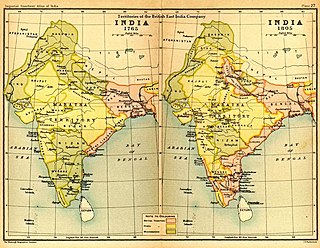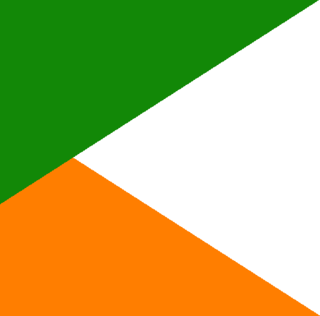History
Rana Ratansingh Alias Ranoji from Rajputana (Rajasthan) and ancestor of the family Shrimant Kalojiraje Gharge-Desai-Deshmukh received the Sur-Deshmukhi of Nimsod along with 72 villages from Muhammad bin Tughluq, the sultan of Delhi in 1342 during his peninsular campaign. In 1536 Santajiraje Gharge-Desai-Deshmukh received various fiefs from the Ibrahim Adil Shah I ruler of Bijapur Sultanate in the Shirol area, and in 1615 Shrimant Ramraoraje from Ibrahim Adil Shah II in Raibaj and Kittur and remained one of the largest Deshmukhs of Adil Shahi.
During the Maratha rule, the family served as the important milestone of the Maratha Empire with blood relationships with various ruling families of those days, were in forefront in continuous War of 27 years between 1682 and 1707 that resulted in the end of the Mughal Empire in India and brought most of the sub-continent under Maratha control. In 1732, Jijasinghraje alias Abbasaheb Gharge-Desai-Deshmukh received Saranjam of 12 more villages and title of Saranjamdar-Deshmukh from Maratha King Chattrapati Shahu of Satara for lieu of military service rendered to the state and total Vatan of 84 villages in Nimsod Pargana was made hereditary.The dowager Queen Tarabai was closely related to Shrimant Jijasinghraje alias Abbasaheb.
From time to time, Deshmukhs of Nimsod supplied quality horses to the Maratha Army. In 1761, son of Jijasinghraje, Shrimant Sidhojiraje Gharge-Desai-Deshmukh, along with his 2000 cavalry participated as one of the Commanders of the Maratha Army in one of the largest battles fought in the 18th century, the Third Battle of Panipat and was killed in the battle. He was also part of the Maratha army which defeated the first Afghan invasion of India in 1757 to 1759 and brought the present-day North West Frontier province of Pakistan under Maratha control.
After the Third Anglo-Maratha War in 1818, Nimsod State came under British rule. The rajas of Nimsod were entitled to a nominal annual pension of Rs 60,000 by the British. At that time, one branch of the family moved to Shirol and changed the family seat from Nimsod because Nimsod was an arid region with very scarce rainfall. Sidhojiraje's grandson Yashojiraje (Shirol branch) acknowledged the changing circumstances and introduced the family to business. The Shirol branch of Gharge-Deshmukh's acquired the surname Desai which was prevalent amongst the landlords of South Maharashtra and Karnataka. The Shirol branch holds the traditional rights to issue coins on behalf of the Emperor of Delhi and received the noble title Shikke-i-Bahadur from the Emperor of Delhi. The title Deshmukh was almost dropped except for its occasional use in marriage invitation cards, so much so that people in Shirol are not aware of the title now. They got into the business of money lending (Sahukari) and through this profession, the Shirol branch of Gharge-Deshmukhs acquired wealth, name and fame in Kolhapur District.
During the British Raj, Shrimant Raje Dattajirao, alias Krishnarao, held huge loans to various landlords (Zamindars) of those days and Shrimant Yashwantrao constructed the famous Vithal temple as a memorial to Shrimant Jijasinghraje alias Abbashaeb in Shirol which is the masterpiece of Maratha architecture.
During the Indian independence movement, Dinkarrao Gharge-Desai (Deshmukh) served as the close associate of Mahatma Ghandhi and one of the national leaders of the Indian National Congress. He was sent for four years' rigorous imprisonment in Katewar in Gujarat in 1930 for participating in Dandi Salt Satyagraha with Mahatma Ghandhi and again for four years in Yerawada in Pune during the Quit India Movement in 1942 for removing the Union Jack flag and putting the Indian Tri-Colour on Shaniwar Wada in Pune. He remained one of the highly respected leaders of the Indian freedom movement. Mahatma Ghandhi used to call him "Dinkarbhai". He was awarded with special a Galantry bronze medal by Prime Minister Indira Ghandhi in 1971 for his contribution to the Indian freedom movement. Shrimant Raje Dattajirao's son Shrimant Jaisingh was among the first five gold medalists of India in M. B. A from England and is a well-known Indian barrister.

The Maratha Empire, or the Maratha Confederacy, was an early modern Indian confederation that came to dominate much of the Indian subcontinent in the 18th century. Maratha rule formally began in 1674 with the coronation of Shivaji as the Chhatrapati. Although Shivaji came from the Maratha caste, the Maratha empire also included warriors, administrators and other notables from Maratha and several other castes from Maharashtra. They were responsible for weakening the Mughal control over the Indian subcontinent. Maratha rule officially ended in 1818 with the defeat of Peshwa Bajirao II at the hands of the English East India Company.

Satara is a city located in the Satara District of Maharashtra state of India, near the confluence of the river Krishna and its tributary, the Venna. The city was established in the 16th century and was the seat of the Chhatrapati of Maratha Empire, Shahu I. It is the headquarters of Satara Tehsil, as well as the Satara District. The city gets its name from the seven forts (Sat-Tara) which are around the city. The city is known as a Soldier's city as well as Pensioner's city.
Scindia dynasty, is a Hindu Maratha dynasty of Kunbi origin that ruled the erstwhile State of Gwalior. It had the Patil-ship of Kumberkerrab in Wai. It was founded by Ranoji Scindia, who started as a personal servant of the Peshwa Bajirao I. Ranoji and his descendents along with their rivals the Holkars, played a leading role during the Maratha ascendency in North india during the 18th century. The Gwalior state was a princely state under the British Raj during the 19th and the 20th centuries. After India's independence in 1947, several members of the Scindia family went on to enter Indian politics.

Balajirao Bhat, also known as Nana Saheb, was the 8th Peshwa of the Maratha Empire in India. He was appointed as Peshwa in 1740 upon the death of his illustrious father, the Peshwa Bajirao I.

The Gaekwads of Baroda are a Hindu Maratha dynasty of Kunbi origin of the former Maratha Empire and its subsequent Princely States. A dynasty belonging to this clan ruled the princely state of Baroda in western India from the early 18th century until 1947. The ruling prince was known as the Maharaja Gaekwad of Baroda. With the city of Baroda (Vadodara) as its capital, during the British Raj its relations with the British were managed by the Baroda Residency. It was one of the largest and wealthiest princely states existing alongside British India, with wealth coming from the lucrative cotton business as well as rice, wheat and sugar production.

The Maratha Conquests were a series of conquests in the Indian subcontinent which led to the building of the Maratha Empire. These conquests were started by Shivaji in 1659, from the victory at the Battle of Pratapgad against Bijapur. The expansion of the empire was limited and interrupted by the Mughal conquests of south India by Mughal emperor Aurangzeb. Marathas were forced to defend their territories against the overwhelmingly strong Mughal army in the 27 years long Deccan wars. They were able to defend their territories and gain an upper hand over Mughals in the sustained conflict.
Mahadik is a surname mainly found in Maharashtra and surrounding states of India. The surname is mainly found among Maratha (caste). Original kingdom: Bagalkot in Karnataka
Pant Pratinidhi family is a prominent aristocratic noble family of India, who served as Pratinidhis to Chhatrapatis of Maratha Empire and later became rulers of the Princely states of Aundh and Vishalgad.
Keshavrao Marutrao Jedhe (Deshmukh) was an Indian independence activist and politician from Pune. He served as a leading figure in the Indian National Congress, and in the Samyukta Maharashtra movement during independence. The famous Swargate chowk in Pune is named after him.

Kolhapur State or Kolhapur Kingdom (1710–1949) was a Maratha princely State of India, under the Deccan Division of the Bombay Presidency, and later the Deccan States Agency. It was considered the most important of the Maratha principalities with the others being Baroda State, Gwalior State and Indore State. Its rulers, of the Bhonsle dynasty, were entitled to a 19-gun salute – thus Kolhapur was also known as a 19-gun state. The state flag was a swallow-tailed saffron pennant.
The History of Satara district can be traced back to 200 BCE. Historical inscriptions of circa 200 BCE indicate the oldest known place in Satara district in Maharashtra is Karad. It is also believed that the Pandavas stayed in Wai, then known as 'Viratnagari', in the 13th year of exile.
Attock Khurd is a small town located on the Indus River in the Attock District of Punjab Province in Pakistan. Khurd and Kalan are Persian words, themselves derived from Sanskrit words, which mean small and big, respectively. When two villages have the same name, they are distinguished as Kalan and Khurd with the villages' names.

Bhor State was one of the 9-gun salute Maratha princely states of British India. It was the only state belonging to the Poona Agency under the Bombay Presidency, which became later part of the Deccan States Agency. Along with Akkalkot State, Aundh State, Phaltan State, Nimsod State and Jath State, it was one of the Satara Jagirs.

Phaltan State was one of the non-salute Maratha princely states of British India. It was ruled by the Nimbalkar clan of the Marathas. It was under the central division of the Bombay Presidency, under the states of the Kolhapur-Deccan Residency, Satara Agency, and later the Deccan States Agency. Its capital was Phaltan town, located in present-day Maharashtra.

Mudhol State was a princely state during the British Raj. The rulers were from the Ghorpade clan of the Marathas. It was one of the former states of the Southern Maratha Country and its capital was the city of Mudhol in present-day Bagalkote District of Karnataka State in India. The last ruler was HH Shrimant Raja Bhairavsinhrao Malojirao Ghorpade II. Mudhol acceded to the Dominion of India on 8 March 1948, and is currently a part of Karnataka state.

The following list includes a brief about the titles of nobility or orders of chivalry used by the Marathas of India and by the Marathis/Konkanis in general.
Madhavrao Khanderao Bagal, also called Bhai Madhavrao Bagal, was a noted writer, artist, journalist, social reformer, political activist, orator and freedom fighter from Kolhapur.
The Bhat Peshwa family earlier known as Bhat family is a prominent Indian Chitpavan Brahmin family who dominated India for around 100 years in the late 18th century and early 19th century. Most of the members in this family were the Peshwas in the Peshwa Era of the Maratha Empire, and Peshwa later became their family name. During their regime, most of the Indian subcontinent was under their control. The last Peshwa, Baji Rao II, was defeated by the British East India Company in the Third Anglo-Maratha War in 1818. The territory was annexed to the British East India Company's Bombay Presidency, and he was pensioned

Nimsod State was one of the Non-Salute Maratha Princely state of British India. It was ruled by the Gharge-Desai (Deshmukh) clan which is one of the oldest ruling clans in India. The clan is Agnivanshai Kshatriya one of the most ancient in India. It was under the central division of the Bombay Presidency. Its capital was Nimsod town, located in present-dayMaharashtra.Its flag is Right-angle triangle, red in colour with Coat of arms of the State on it.
Mhaswad was a Jagir during the Maratha Empire and later become part of Deccan States Agency of the British Raj. It was governed by Mane who were Feudatories of Nimsod State. Mhaswad is situated on bank of Manganga river, Historically Mann region was once ruled by Chalukya dynasty of Badami. In 11th century Chalukya rulers build this temple as it was considered to be their ancestors god, latter in 1738 another Jagirdar family under Nimsod State named as Dubal built half of the temple,












